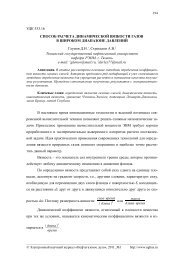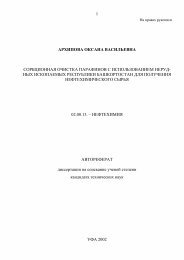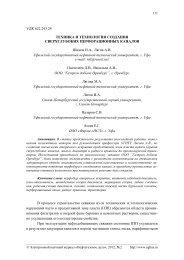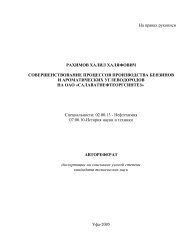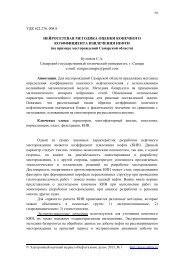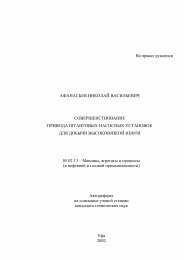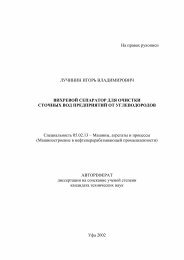FCC PROCESS OF HEAVY FEED STOCK WITH IMPROVED YIELD ...
FCC PROCESS OF HEAVY FEED STOCK WITH IMPROVED YIELD ...
FCC PROCESS OF HEAVY FEED STOCK WITH IMPROVED YIELD ...
You also want an ePaper? Increase the reach of your titles
YUMPU automatically turns print PDFs into web optimized ePapers that Google loves.
<strong>FCC</strong> <strong>PROCESS</strong> <strong>OF</strong> <strong>HEAVY</strong> <strong>FEED</strong> <strong>STOCK</strong><br />
<strong>WITH</strong> <strong>IMPROVED</strong> <strong>YIELD</strong> <strong>OF</strong> LIGHT OLEFINS<br />
Bulatov R.M., Jirnov B.S.<br />
Ufa State Petroleum Technological University<br />
There is written about most perspective method of <strong>FCC</strong> process with improved yield of<br />
light olefins using in industry. It is described <strong>FCC</strong> process for heavy feed stock which modified<br />
to produce greater yields of light olefins; particularly, ethylene, propylene and butylene with<br />
less production of dry gas; i.e., hydrogen, methane and ethane at relatively high conversion.<br />
Keywords: catalytic cracking process, <strong>FCC</strong> process, propylene, heavy feed stock, light<br />
olefins, ZSM additives, medium pore zeolite, coked catalyst<br />
Propylene is second in importance only to ethylene as a petrochemical raw<br />
material building block. Propylene has traditionally been obtained as a by-product from<br />
steam cracking to produce ethylene and from refinery fluidized catalytic cracking<br />
processes to produce gasoline. Propylene is conventionally produced through <strong>FCC</strong><br />
processes, dehydrogenation processes, and predominantly from steam cracking<br />
processes. The projected growth in demand for propylene has started to exceed that of<br />
ethylene so that existing processes cannot satisfy the foreseeable future growth in the<br />
demand for propylene. Typically, however, <strong>FCC</strong> units produce only around 5 wt - % of<br />
propylene. As a result, propylene production from <strong>FCC</strong> units is forecast to grow by<br />
more than 40 % over the next 10 years, with a large part of this demand coming<br />
from Asia. Consequently, modifications to <strong>FCC</strong> units can increase propylene production<br />
are necessary. Several references disclose modified <strong>FCC</strong> processes to improve<br />
propylene yields [5].<br />
The propylene demand from <strong>FCC</strong> is growing at a faster rate than global<br />
<strong>FCC</strong> capacity, and the propylene yields from <strong>FCC</strong> are increasing to keep up with<br />
demand (Figure 1).<br />
_____________________________________________________________________________<br />
© Oil and Gas Business, 2009 http://www.ogbus.ru/eng/
60%<br />
50%<br />
40%<br />
30%<br />
20%<br />
10%<br />
C3=<strong>FCC</strong><br />
Figure 1: Forecast <strong>FCC</strong> capacity and propylene production<br />
(Source: Chemical Market Associates, Inc 2007)<br />
Fluidized catalytic cracking, or <strong>FCC</strong>, is a well-known and widely practiced<br />
process for converting heavy hydrocarbons, gasoils and residues into lighter hydro-<br />
carbon fractions. The process for the catalytic cracking of heavy hydrocarbons, gasoils<br />
and residues is well known and currently practiced in all types of <strong>FCC</strong> units processing<br />
a variety of these feedstocks [1].<br />
cumulative grow th<br />
0%<br />
2003 2004 2005 2006 2007 2008 2009 2010 2011 2012 2013 2014 2015<br />
In general terms, the process for the cracking of hydrocarbon feedstocks relies<br />
on contact with fluidized catalytic particles in a reaction zone maintained at appropriate<br />
temperatures and pressures. When the heavier feed contacts the catalyst and is cracked<br />
to lighter products, carbonaceous deposits, commonly referred to as coke, form on the<br />
catalyst and deactivate it. The deactivated, or spent, catalyst is separated from the<br />
cracked products, stripped of removable hydrocarbons and passed to regenerator where<br />
the coke is burned from the catalyst in the presence of air to produce a substantially<br />
regenerated catalyst. The combustion products are removed from regenerator as flue<br />
gas. The regenerated and heated catalyst is then recycled to the <strong>FCC</strong> unit.<br />
Fluidization of the catalyst particles by various gaseous streams allows the<br />
transport of catalyst between the reaction zone and regeneration zone. Methods for<br />
cracking hydrocarbons in a fluidized stream of catalyst, transporting catalyst between<br />
reaction and regeneration zones, and combusting coke in the regenerator are well known<br />
by those skilled in the art of <strong>FCC</strong> processes.<br />
Various methods and apparatus have been proposed for increasing or enhancing<br />
the output of particular product streams from the <strong>FCC</strong> unit. Many of these processes<br />
increase propylene yields by increasing conversion by utilizing longer reaction times<br />
_____________________________________________________________________________<br />
© Oil and Gas Business, 2009 http://www.ogbus.ru/eng/<br />
2
and hot catalyst temperatures. One such process called deep catalytic cracking (“DCC”)<br />
requires 5 to 10 seconds of contact time to increase propylene yields. However, this<br />
process also yields a relatively substantial quantity of undesirable dry gas; i.e.,<br />
hydrogen, ethane and methane. New <strong>FCC</strong> catalyst technologies are being developed to<br />
enable refiners to achieve the challenging propylene yields required to meet the<br />
growing demand for propylene from <strong>FCC</strong>. In some cases, ancillary reactors and other<br />
treatment vessels have been provided to treat a particular fraction or reaction product<br />
stream. In some instances, multiple reactors are provided each with a different feed, in<br />
order to derive a particularly desired product stream. An <strong>FCC</strong> process is modified to<br />
produce greater yields of light olefins; particularly, ethylene, propylene and butylene<br />
with less production of dry gas; i.e., hydrogen, methane and ethane at relatively high<br />
conversion.<br />
<strong>FCC</strong> process for obtaining light olefins comprises contacting a hydrocarbon feed<br />
stream with blended catalyst comprising regenerated catalyst and coked catalyst. The<br />
catalyst has a composition including a first component and a second component. The<br />
second component comprises a zeolite with no greater than medium pore size wherein<br />
zeolite comprises at least 1 % wt. of catalyst composition. The contacting occurs in a<br />
riser to crack hydrocarbons in the feed stream and obtain cracked stream containing<br />
hydrocarbon products including light olefins and coked catalyst. The cracked stream is<br />
passed out of an end of the riser such that hydrocarbon feed stream is in contact with the<br />
blended catalyst in the riser for less than or equal to 2 seconds on average. The<br />
hydrocarbon products including light olefins are separated from the coked catalyst. The<br />
first portion of coked catalyst is passed to regeneration zone in which coke is combusted<br />
from catalyst to produce regenerated catalyst. Second portion of coked catalyst is<br />
blended with regenerated catalyst and introduced to the riser. The regenerated catalyst<br />
has substantially the same relative proportions of the first component and the second<br />
component as the blended catalyst that contact the hydrocarbon feed stream [9].<br />
Recycling coked catalyst including large pore zeolite or active amorphous<br />
material and zeolite with no greater than medium average pore size and blending it with<br />
regenerated catalyst improves the yield of light olefins and the overall conversion. It is<br />
the case even at lower residence times. Additionally, the lower temperature of the<br />
_____________________________________________________________________________<br />
© Oil and Gas Business, 2009 http://www.ogbus.ru/eng/<br />
3
catalyst resulting from blending hot regenerated catalyst and cooler recycled catalyst<br />
improve olefin selectivity.<br />
An embodiment of this method is a process for fluidized catalytic cracking of a<br />
hydrocarbon feed stream to obtain light olefins. The process comprises contacting the<br />
hydrocarbon feed stream with a catalyst composition including at least 1.0 % wt. of the<br />
zeolite having no greater than medium average pore size and at least 0.1 % wt. coke.<br />
This method is more fully explained in the context of a <strong>FCC</strong> process that is<br />
modified to yield greater quantities of light olefins. Light olefins are olefins with six or<br />
less carbon atoms and, preferably, less than five carbon atoms.<br />
The catalyst comprises two components that may or may not be on the same<br />
matrix. The two components are circulated throughout the entire system. The first<br />
component may include any of the well-known catalysts that are used in the art of<br />
fluidized catalytic cracking, such as an active amorphous clay-type catalyst or high<br />
activity, crystalline molecular sieve. Molecular sieve catalysts are preferred over<br />
amorphous catalysts because of their much-improved selectivity to desired products.<br />
Zeolites are the most commonly used molecular sieves in <strong>FCC</strong> processes.<br />
Preferably, the first catalyst component comprises a large pore zeolite, such as an Y-<br />
type zeolite, an active alumina material, a binder material, comprising either silica or<br />
alumina and an inert filler such as kaolin [8].<br />
The zeolitic molecular sieves appropriate for the first catalyst component should<br />
have a large average pore size. Typically, molecular sieves with a large pore size have<br />
pores with openings of greater than 0.7 nm in effective diameter defined by greater than<br />
10 and typically 12 membered rings. Pore Size Index of large pores are above about 31.<br />
Suitable large pore zeolite components include synthetic zeolites such as X-type<br />
and Y-type zeolites, mordenite and faujasite. Y zeolites with low rare earth content are<br />
preferred in the first catalyst component. Low rare earth content denotes less than or<br />
equal to about 1.0% wt. rare earth oxide on the zeolite portion of the catalyst.<br />
The second catalyst component comprises a catalyst containing, medium or<br />
smaller pore zeolite catalyst exemplified by ZSM-5, ZSM-11, ZSM-12, ZSM-23,<br />
ZSM- 35, ZSM-38, ZSM-48, and other similar materials. This second catalyst<br />
component preferably disperses the medium or smaller pore zeolite on a matrix<br />
comprising a binder material such as silica or alumina and inert filer material such as<br />
_____________________________________________________________________________<br />
© Oil and Gas Business, 2009 http://www.ogbus.ru/eng/<br />
4
kaolin. These catalyst compositions have a crystalline zeolite content of 10 to 25 wt-%<br />
or more and a matrix material content of 75 to 90 wt-%. Catalysts containing 25 wt-%<br />
crystalline zeolite material are preferred. Catalysts with greater crystalline zeolite<br />
content may be used, provided they have satisfactory attrition resistance. Medium and<br />
smaller pore zeolites are characterized by having an effective pore opening diameter of<br />
less than or equal to 0.7 nm, rings of 10 or fewer members and a Pore Size Index of less<br />
than 31.<br />
ZSM-5 and ST-5 type zeolites are particularly preferred since their high coke<br />
resistivity will tend to preserve active cracking sites as the catalyst composition makes<br />
multiple passes through the riser, thereby maintaining overall activity. ZSM-5 additives<br />
are a very effective solution for increasing propylene yield in the <strong>FCC</strong> unit. This<br />
approach gives the refiner a great deal of flexibility, as additive usage can be adjusted<br />
according to changes in propylene demand and to optimize operation within unit<br />
constraints such as wet gas compressor loading. ZSM-5 generates propylene by<br />
selectively cracking olefins in the gasoline boiling range. As the amount of ZSM-5<br />
additive in the catalyst inventory increases, the incremental yield of propylene produced<br />
per percent of additive decreases. Propylene yield reaches a plateau once the ZSM-5<br />
concentration reaches around 10 %. The diminishing effectiveness of ZSM-5 at higher<br />
concentrations occurs because the olefins in the gasoline become depleted [5].<br />
The first catalyst component will comprise the balance of the catalyst<br />
composition. The relative proportions of the first and second components in the catalyst<br />
composition will not substantially vary throughout the <strong>FCC</strong> unit.<br />
The high concentration of the medium or smaller pore zeolite in the second<br />
component of the catalyst composition improves selectivity to light olefins by further<br />
cracking the lighter naphtha range molecules. But at the same time, the resulting smaller<br />
concentration of the first catalyst component still exhibits sufficient activity to maintain<br />
conversion of the heavier feed molecules to a reasonably high level.<br />
<strong>FCC</strong> feedstocks, suitable for processing by this method, include conventional<br />
<strong>FCC</strong> feeds and higher boiling or residual feeds. The most common of the conventional<br />
feeds is vacuum gas oil which is typically a hydrocarbon material having boiling range<br />
of from 343-552 °C and is prepared by vacuum fractionation of atmospheric residue.<br />
Heavy or residual feeds, i.e., boiling above 499 °C, are also suitable.<br />
_____________________________________________________________________________<br />
© Oil and Gas Business, 2009 http://www.ogbus.ru/eng/<br />
5
The amount of blended catalyst that contacts the feed will vary depending on<br />
the temperature of the regenerated catalyst and the ratio of recycled to regenerated<br />
catalyst comprising the catalyst blend. Generally, the blended catalyst to feed will be in<br />
a ratio of from 10 to 50. Preferably, the blended catalyst to feed will be in ratio from 10<br />
to 30 and more preferably in ratio from 15 to 25. The high catalyst-to-feed ratio will<br />
operate to maximize conversion which tends to favor light olefin production.<br />
Although it has been well established within the art of <strong>FCC</strong> that increasing<br />
catalyst-to-feed ratios will increase conversion, catalyst-to-feed ratios cannot be easily<br />
increased since this ratio is not an independent variable in standard <strong>FCC</strong> units. Rather<br />
the ratio of catalyst to feed is dependent on the heat balance limitations of the unit.<br />
Consequently, only relatively low catalyst-to-feed ratios of 4 to 10 are typically obser-<br />
ved. Such a means of increasing catalyst-to-feed ratios, however, was not expected to<br />
maintain high catalyst activities due to the coke deactivation of the catalyst. Reduction<br />
the catalyst-to-feed contact results in an increased light olefin yield and a decreased dry<br />
gas yield.<br />
Blends of coked and regenerated catalyst have comparable activity to that of the<br />
regenerated catalyst. Consequently, recycling coked catalyst can be effectively utilized<br />
to increase the catalyst-to-feed ratios, thereby, allowing operation at very short catalyst-<br />
to-feed contact times with catalyst that has been heavily diluted with catalyst containing<br />
medium to small pore zeolite while still maintaining high conversions. Maximizing<br />
conversion is particularly important in order to maximize yields of key light olefins.<br />
The catalyst composition with a relatively low concentration of the first catalyst<br />
component and relatively high concentration of second catalyst component still exhibits<br />
improved conversion and selectivity to light olefins. Even when a portion of the catalyst<br />
composition is coked and when the riser residence time is very short were completely<br />
unexpected [8].<br />
Preferably, the blended catalyst will comprise a 1:1 ratio of recycled catalyst to<br />
regenerated catalyst. The amount of coke on the recycled catalyst portion returning to<br />
regeneration will vary depending on the number of times the catalyst particle has<br />
recycled through the riser. Nevertheless, the coked catalyst portion entering to the<br />
regeneration as well as the recycled catalyst portion could range from average coke<br />
concentration.<br />
_____________________________________________________________________________<br />
© Oil and Gas Business, 2009 http://www.ogbus.ru/eng/<br />
6
Reduction riser contact time effects in the presence of a catalyst composition<br />
containing a large quantity of a small to medium pore zeolite component, and in a pro-<br />
cess system where the temperature of the catalyst contacting the feed is representative<br />
of a recycled catalyst system. The study was conducted in a <strong>FCC</strong> riser operating under<br />
conditions favorable to obtain greater yields of light olefins. Tests were performed using<br />
three riser residence times: 2.5 seconds, 1.5 seconds, and 0.7 seconds. A riser in the<br />
<strong>FCC</strong> process was run at 0,141 MPa, a regenerator temperature of around 654 °C an<br />
outlet temperature of 566 °C, a feed temperature of about 121 °C, a riser hydrocarbon<br />
partial pressure of about 0,076 MPa, and a catalyst-to-feed ratio of about 28. The results<br />
for each of the residence times in the riser are presented in Table 1.<br />
Yield of light products against residence time<br />
Riser Time (sec.) 0,7 1,5 2,5<br />
Dry Gas (wt-%) 2,29 2,78 4,11<br />
Ethylene (wt-%) 5,96 6,88 6,02<br />
Propylene (wt-%) 21,64 22,30 19,36<br />
Butylene (wt-%) 14,12 13,41 12,56<br />
Table 1<br />
Decreasing the residence time in the riser from 2,5 seconds to 0,7 seconds<br />
increased the relative propylene yield by 12 % with a corresponding decrease in dry gas<br />
of 44 %. This corresponds to an absolute yield increase of 2,3 % wt. propyl ene and<br />
1,8 % wt. decrease in dry gas. Decreasing the residence time in the riser from 2,5<br />
seconds to 1,5 seconds increased the relative propylene yield by 15 % with the<br />
corresponding decrease in dry gas of 32 %. Ethylene production increased in 1,5 second<br />
riser residence time and nominally decreased at 0,7 second riser residence time.<br />
Additionally, butylene production increased with reductions in riser residence time.<br />
Surprisingly, the 2,5 second residence time actually experienced lower conversion than<br />
the shorter times of 1,5 or 0,7 seconds. It attributed this drop in conversion due to a<br />
reduction of secondary reactions such as olefin oligomerization, which produce higher<br />
molecular weight components.<br />
One of the benefits of the present method is that recycling of coked catalyst and<br />
mixing it with regenerated catalyst can reduce the catalyst temperature entering the riser<br />
by 28 °C to 83 °C, depending on the regenerator temperature and the coked catalyst<br />
_____________________________________________________________________________<br />
© Oil and Gas Business, 2009 http://www.ogbus.ru/eng/<br />
7
ecycle rate. A study was conducted to demonstrate the effect of lower catalyst<br />
temperature contacting the feed in a short riser residence time system where the catalyst<br />
contained a high concentration of a medium pore zeolite. The effect of catalyst<br />
temperature contacting the feed was observed at 649 °C and 732 °C with catalyst<br />
composition containing 20 % wt. of an additive containing about 25 % wt. medium pore<br />
zeolite and 80 wt-% of catalyst containing Y-type zeolite. The high catalyst tempe-<br />
rature, 732 °C, was chosen to represent a standard <strong>FCC</strong> regenerator temperature. The<br />
lower catalyst inlet temperature of 649 °C resulted in a catalyst-to-feed ratio of 28<br />
compared to the catalyst-to-feed ratio of 12 used for the hotter catalyst inlet temperature<br />
of 732 °C. Since the riser outlet temperature was maintained at 566 °C in both cases,<br />
decreasing the catalyst inlet temperature forces operation at higher catalyst-to-feed ratio<br />
in the riser. The results are presented in Table 2.<br />
Yield of light products against temperature<br />
Catalyst Temperature 732 °C 649 °C<br />
Catalyst-to-Feed Ratio 12 28<br />
Inert Catalyst (wt-%) 0 60<br />
Dry Gas (wt-%) 4,07 2,97<br />
Ethylene (wt-%) 5,31 5,31<br />
Propylene (wt-%) 16,97 20,69<br />
Butylene (wt-%) 12,67 14,52<br />
Gasoline (wt-%) 26,32 22,98<br />
Table 2<br />
The comparison of the effect of catalyst temperature on propylene yield<br />
indicates that reducing the catalyst inlet temperature by 66 °C results in a 22 % relative<br />
increase and a 3,7 % wt. absolute increase in propylene yield. Additionally, a 15 %<br />
relative increase and a 1,9 % wt. absolute increase in butylenes and a 27 % relative<br />
decrease and a 1,1 % wt. absolute decrease in dry gas was observed with the reduction<br />
in catalyst inlet temperature. Conversion for the lower catalyst temperature was also<br />
improved.<br />
Another comparison was conducted feed conversion over varying concentrations<br />
of a component additive containing ZSM-5. The additive level was varied from 0 to<br />
40 %. All tests were run with a catalyst to feed ratio of about 28, a riser outlet<br />
temperature of 566 °C, a riser partial pressure was 0,0793 MPa, and a feed-to-catalyst<br />
contact time in the riser of 1,5 seconds. Increasing the additive to very high levels had<br />
_____________________________________________________________________________<br />
© Oil and Gas Business, 2009 http://www.ogbus.ru/eng/<br />
8
only a marginal affect on the conversion to light materials that boil under 37 °C. The<br />
data is illustrated in Table 3. Although the conversion does drop slightly from 61,9 to<br />
60.0 % wt. as the additive level is increased from 10 to 40 % wt., the data indicates that<br />
the activity of the standard, Y-type zeolite, <strong>FCC</strong> catalyst has been well maintained even<br />
after high dilution. Since the ZSM-5 additive can only crack lighter, naptha-range<br />
molecules, ZSM-5 addition had been thought to significantly reduce feed conversion at<br />
higher levels. This tests show that significant feed conversion can be achieved at very<br />
high medium pore zeolite additive levels and short catalyst-to-feed contact time using<br />
higher than typical catalyst-to-feed ratios.<br />
Yield of light products against temperature<br />
Table 3<br />
Additive Level. (wt-%) 0 10 20 30 40<br />
Coke (wt-%) 3,51 2,78 2,46 2,30 1,88<br />
Dry Gas (wt-%) 3,36 3,16 3,18 2,71 2,83<br />
Ethylene (wt-%) 2,80 5,01 5,61 6,15 7,51<br />
Propylene (wt-%) 16,21 20,32 20,78 21,33 21,73<br />
Butylene (wt-%) 14,55 14,43 14,18 13,67 12,97<br />
REFERENCES<br />
1. World propylene market // icis.com: everyday internet-pub. 2007. 21 July<br />
URL: http://www.icis.com/v2/chemicals/9076455/propylene/uses.html (review date<br />
07.01.2009).<br />
2. Patent 4289606 US, ICC B01J29/80; C10G11/05; B01J29/08; B01J29/40;<br />
B01J29/00; C10G11/00; C10G11/05. Hydrocarbon cracking with mixture of zeolites Y<br />
and ZSM-5 / M. Elroy, G. Winter, E. William; Exxon Research & Engineering Co. - №<br />
06/131646, filling date 19.03.80, publication date 15.09.81. – 12 p.<br />
3. Patent 07A0143328 Japan, ICC C10G11/00; C10G11/05.. A Novel ZSM-5<br />
Additive to Increase Propylene Production and Octane Rating in <strong>FCC</strong> Gasoline / R.<br />
Hamada; Catalysts & Chemicals Ind. Co., Ltd., JPN. - № 0916-3859, filling date<br />
21.06.06, publication date 15.08.06. – 23 p.<br />
4. Patent 6045690 US, ICC C10G11/18; C10G11/00; C10G35/00. Process for<br />
fluid catalytic cracking of heavy fraction oils / Y. Fujiyama, M. Adachi, T. Okuhara, S.<br />
_____________________________________________________________________________<br />
© Oil and Gas Business, 2009 http://www.ogbus.ru/eng/<br />
9
Yamamoto; Nippon Oil Co., Ltd. - № 08/968499, filling date 12.11.97, publication date<br />
04.04.00. – 8 p.<br />
5. Fosket S. Albemarle AFX technology achieves maximum propylene yield in<br />
<strong>FCC</strong> units. internet-publication. 2007. 23 Oct. URL: http://www.albemarle.com/<br />
Products_and_services/Catalysts/Courier/ALB_AFX_tech_achieves.pdf (review date<br />
20.12.2008).<br />
6. Suchanek A.J. Deactivation of oxidation promoter CO in catalytic cracking<br />
process / A.J. Suchanek, A.S. Moore // Oil and Gas: review -1985. - № 31. - P. 36 - 40.<br />
7. Solyar B.Z. Design of technology adsorption-catalytic treatment of black oil /<br />
B.Z. Solyar, B.М. Jitomirski, Е.М. Soskin // Chemistry and technology of fuel and oil<br />
magazine – 1986. - № 2. - p. 19- 21.<br />
8. Patent 7312370 US, ICC C07C4/06; C10G11/02. <strong>FCC</strong> process with improved<br />
yield of light olefins / P. Rusty, M. Upson, L. Lawrence; UOP LLC. - № 10/316222,<br />
filling date 10.12.02, publication date 25.12.07. – 10 p.<br />
9. Patent 5997728 US, ICC B01J29/90; C10G11/05; B01J29/00; C10G11/00;<br />
C10G11/05. Catalyst system for maximizing light olefin yields in <strong>FCC</strong> / A. Yusuf, G.<br />
Buchanan, J. Scott; Mobil Oil Corporation. - № 08/048964, filling date 16.04.93,<br />
publication date 07.12.99. – 14 p.<br />
10. Patent 20080011644 US, ICC C10G11/00. Ancillary cracking of heavy oils<br />
in conjuction with <strong>FCC</strong> unit operations / D. Christopher F. Fujiyama, O. Yuichiro O.<br />
Takata. - № 11/487011, filling date 13.07.06, publication date 17.01.08. – 9 p.<br />
11. Wood L. 2008 Study on the Propylene Market Outlook Includes Profiles of<br />
Major Producers // Research and Markets 2008. URL:<br />
http://www.researchandmarkets.com/research/3fe1da/propylene_market_o (review date<br />
20.12.2008).<br />
12. Patent 5296131 US, ICC C10G11/18; C10G11/00; C10G11/18; C10G35/14.<br />
Process for short contact time cracking / B. Raterman, F. Michael; Mobil Oil<br />
Corporation. - № 07/984630, filling date 12.02.92, publication date 22.03.94. – 10 p.<br />
13. Patent 5389232 US, ICC C10G11/18; C10G11/00; C10G13/02. Riser<br />
cracking for maximum C3 and C4 olefin yields / A. Yusuf, G. Adornato, M. Johnson,<br />
L. David L. Gerald; Mobil Oil Corporation. - № 07/877919, filling date 04.05.92,<br />
publication date 14.02.95. – 13 p.<br />
_____________________________________________________________________________<br />
© Oil and Gas Business, 2009 http://www.ogbus.ru/eng/<br />
10



